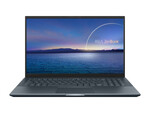Asus ZenBook Pro 15 UX535LH-BN150T
Especificaciones de Portátil(es)

Price comparison
Promedio de 1 puntuaciones (de 2 análisis)
Análisis para el Asus ZenBook Pro 15 UX535LH-BN150T
Origen: Geek Culture
 EN→ES Archive.org version
EN→ES Archive.org versionThe delivery of creative and entertainment prowess is all in a day’s work for this versatile tank that impresses with its many advantages. While its dense, hefty build and lack of connectivity options dull the shine of its appeal factor, the notebook excels at what it does the best – packing all of its capabilities and features into a well-rounded experience – and that’s what truly matters.
Único Análisis, disponible online, Mediano, Fecha: 10/11/2021
Puntuación: Puntuación total: 88% precio: 90% rendimiento: 85% procesamiento: 90%
Origen: Hardware Zone
 EN→ES Archive.org version
EN→ES Archive.org versionThe ASUS ZenBook Pro 15 UX535 makes a good first impression. The 4K display is beautiful and the notebook has pretty nice specifications. Users with lots of files will appreciate that it has a separate 1TB HDD on top of its 512GB SSD, and gamers will rejoice that it has a respectable mid-range discrete GPU (albeit a dated one) for gaming. The only shortcomings that I can see in my time with it are its slightly dated (but still powerful) processor and lack of USB-C charging. If these don’t bother you, the S$2,498 ZenBook Pro 15 UX535 is a very solid 15-inch notebook.
Único Análisis, disponible online, corto, Fecha: 07/28/2021
Comentario
NVIDIA GeForce GTX 1650 Max-Q:
Tarjeta gráfica dedicada de gama media para portátiles delgados y livianos basados en la GTX 1650 pero con velocidades y consumo reducidos. Utiliza la arquitectura Turing (chip TU117 en 12nm FFN) pero sin núcleos Raytracing o Tensor.
Estas tarjetas también deben ser capaces de aguantar todos los juegos actuales, pero la mayoría de ellos en configuraciones de detalles medios y bajos y con bajas resoluciones. Juegos más antiguos, o menos exigentes todavía pueden ser jugados con buena calidad de gráficos.
>> Más información puede ser encontrada en nuestra comparación de tarjetas gráficas moviles y la lista de benchmarks.
i7-10870H:
En la arquitectura de Coffee Lake, un procesador para portátiles grandes y pesados. Integra ocho núcleos de procesador registrados a 2,2 - 5 GHz (los 8 núcleos hasta 4,2 GHz) que soportan HyperThreading. Fabricado en un proceso mejorado de 14nm (14nm++).
>> Más información puede ser encontrada en nuestra comparación de procesadores móviles.




